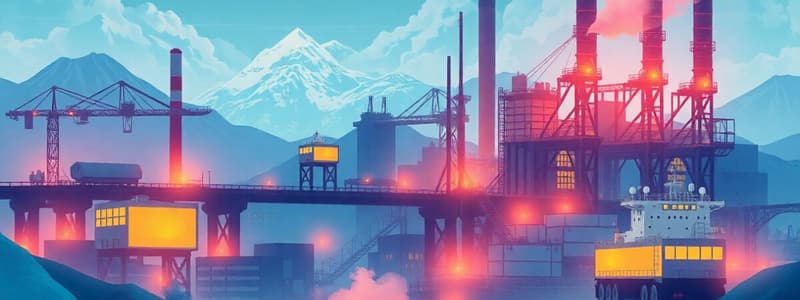Podcast
Questions and Answers
In economies transitioning from primarily agricultural to more diversified structures, what is the most likely driver of rapid growth in the industrial and service sectors?
In economies transitioning from primarily agricultural to more diversified structures, what is the most likely driver of rapid growth in the industrial and service sectors?
- Substantial increases in taxes to fund infrastructure projects.
- Availability of raw materials combined with competitive labor costs. (correct)
- Increased government regulation and control over labor markets.
- Discovery of rare earth minerals leading to technological advancements.
A country is experiencing rapid economic development. How would you expect the demand for goods to change, and what impact would this have on the economy?
A country is experiencing rapid economic development. How would you expect the demand for goods to change, and what impact would this have on the economy?
- Demand stays constant as the population's needs are already met.
- Demand decreases, leading to a contraction in economic activity.
- Demand fluctuates randomly, making economic forecasting impossible.
- Demand increases, fostering further economic expansion. (correct)
A company transforms raw timber into paper products. In which sector of the economy does this manufacturing activity primarily belong?
A company transforms raw timber into paper products. In which sector of the economy does this manufacturing activity primarily belong?
- Secondary Sector (correct)
- Primary Sector
- Quaternary Sector
- Tertiary Sector
Which of the following exemplifies a service provided by the tertiary sector?
Which of the following exemplifies a service provided by the tertiary sector?
What distinguishes the primary sector from the secondary sector in a nation's economy?
What distinguishes the primary sector from the secondary sector in a nation's economy?
A mining company extracts iron ore, which is then used to manufacture steel. How are these activities classified across economic sectors?
A mining company extracts iron ore, which is then used to manufacture steel. How are these activities classified across economic sectors?
If a significant percentage of a developing country's workforce is engaged in agriculture, what broader economic trend does this indicate?
If a significant percentage of a developing country's workforce is engaged in agriculture, what broader economic trend does this indicate?
How do private and public services differ within the tertiary sector, and what are some examples of each?
How do private and public services differ within the tertiary sector, and what are some examples of each?
Flashcards
Main Economic Sectors
Main Economic Sectors
Agriculture, industry, and services are the three main categories.
Primary Sector
Primary Sector
Extracts raw materials from land and water (e.g., farming, mining).
Secondary Sector
Secondary Sector
Processes raw materials from the primary sector into finished goods.
Tertiary Sector
Tertiary Sector
Signup and view all the flashcards
Mining
Mining
Signup and view all the flashcards
Timber Processing
Timber Processing
Signup and view all the flashcards
Paper Manufacturing Sector
Paper Manufacturing Sector
Signup and view all the flashcards
Private Services
Private Services
Signup and view all the flashcards
Study Notes
- Society's production divides into industries or sectors.
- Agriculture, industry, and services constitute the three main industries in many countries.
- A fourth sector focused on research and development exists in several nations.
Agriculture
- In numerous of the world's poorest countries, agriculture engages 70% to 80% of the working population.
- This mirrors the situation in rich countries a century ago.
Development
- Developing countries are experiencing rapid change.
- China, Malaysia, and India are examples of countries where industry and the service sector are growing rapidly.
- Raw material resources coupled with cheap international labor accelerate this change.
- Increased living standards drive up the demand for goods, boosting economic development.
- These countries compete with richer nations in manufacturing technically complex products like cars and IT services.
Sectors of the Workforce in Sweden 1900–2000
- The primary sector extracts raw materials from land and water, including agriculture, forestry, fishing, and mining.
- BHP, the world's largest mining company with iron ore mines in Australia, operates in the primary sector.
Secondary Sector
- The secondary sector processes raw materials from the primary sector into semi-finished and finished consumer goods.
- Timber converts into planks and boards.
- Wood processes into pulp and then into paper.
- Semi-finished products (components) assemble into cars, bicycles, or television sets.
- Stora Enso Oyj, based in Finland, manufactures pulp and paper in the secondary sector.
Tertiary Sector
- The tertiary sector, also known as the service sector, covers all production of services, both private and public.
- Private services are offered by banks, insurance companies, healthcare companies, independent schools, transport companies, and hotels.
- Public services include education, healthcare, order and security, and the country's defense, provided by the state, regions, and municipalities.
Quaternary Sector
- The quaternary sector focuses on research and information.
- Research in IT, pharmaceuticals, biotechnology, aviation, space activities, and AI falls under this sector.
- This sector relies heavily on well-educated employees.
- AstraZeneca, an international pharmaceutical company, conducts drug research and development in Sweden, making it a part of the quaternary sector.
Studying That Suits You
Use AI to generate personalized quizzes and flashcards to suit your learning preferences.




